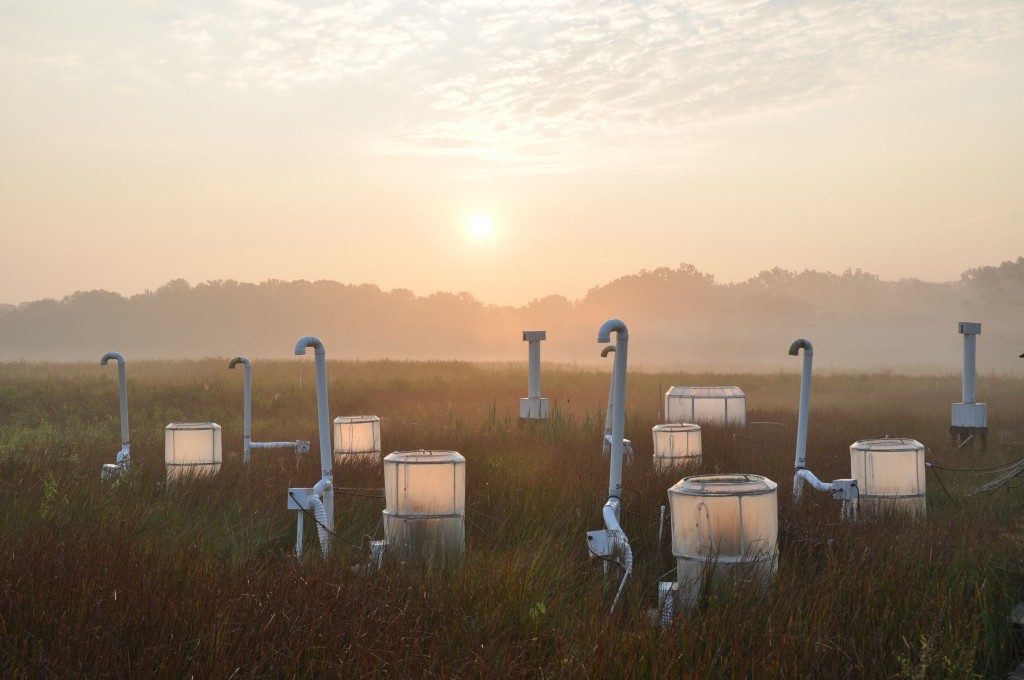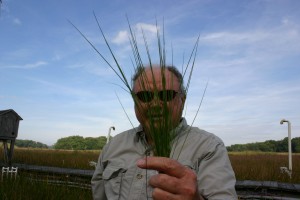by Kristen Minogue

“Marsh of the Future.” Bert Drake built these chambers in 1987. Inside half of them, he raised CO2 to roughly 700 parts per million, a level we could reach before the end of the century. (Tom Mozdzer/SERC)
Under spiked carbon dioxide levels, wetland plants can absorb up to 32 percent more carbon than they do today, according to a 19-year study published in Global Change Biology from the Smithsonian Environmental Research Center. With atmospheric carbon dioxide passing 400 parts per million in May, there’s hope that wetlands could help soften the blow of climate change.
But that isn’t the shocking part for plant physiologist Bert Drake. The shocking part is that plants are absorbing the carbon in ways they didn’t expect.
Drake created the Smithsonian’s Global Change Ecological Research Wetland in 1987, on a marsh in Edgewater, Md. Back then, most scientists thought plants would gradually stop responding to rising CO2. Whether or not they could gobble up extra carbon over the long run—and act as powerful carbon sinks—was not known.
To simulate the world of the future, Drake’s team surrounded marsh plots with open-top Mylar chambers. They left half of the chambers exposed to today’s atmosphere. In the other half they added carbon dioxide gas and raised the level to 700 ppm, roughly doubling the CO2 concentration as it was in 1987. Other plots of land were left without chambers. Then they compared levels of CO2 going in and going out to determine how much carbon was being exchanged between the wetland and the atmosphere.
More futuristic experiments at the SERC Marsh >>
They tested two types of plants: C3 plants–the dominant type, which includes trees and 95 percent of the plant species on Earth–and C4 plants, which include sugar cane and many grasses. On the marsh, half of the plots they analyzed were dominated by the C3 sedge Scirpus olneyi, and half by the C4 grass Spartina patens.
The team’s first discovery was fairly straightforward. C3 plants saw the largest increases. Over the 19-year study, they absorbed on average 32 percent more carbon under high CO2. The C4 plants, however, were a different story.

Bert Drake holds up a cluster of the marsh grass Spartina patens. C4 plants like Spartina weren’t expected to absorb extra CO2, but they surprised scientists in a recent study. (SERC)
Drake thinks the reason could be that they become better at holding onto water. Plants lose a great deal of water as they absorb carbon. A single carbon molecule can cost the plant up to 500 or 600 water molecules, Drake said. But as CO2 levels in the air rise, openings in the plants called stomata start to shrink.
“What happens in high CO2 is that these little openings close down. So that now, instead of requiring 600 molecules of water, they now only require two or three hundred. That’s really big news,” Drake said. If the cost goes down, the plants can afford to absorb more carbon.
And there was another surprise: Plants did not just absorb extra carbon during the day, during photosynthesis. When CO2 levels went up, they also released less of it at night.
Like animals, plants respire whenever they need to use energy. They do it by using oxygen to break down sugar, and release carbon dioxide as a byproduct. But when the sun is shining, photosynthesis drowns out the signal. Drake’s team could only track how much CO2 the plants were releasing at night.
“When you shut the lights off and the sun goes down, then the plants are still respiring, because they’re still working, they’re still growing,” said Drake. “And they’re giving off carbon dioxide.”
Scientists aren’t sure why ratcheting up CO2 would make the plants release less of it than before. Drake speculates it might be due in part to a decrease in the amount of nitrogen in both types of plants when they grew in the high-atmospheric CO2, but other explanations are also on the table.
However, there’s a catch. Climate also affected how much the plants absorbed. Droughts crippled the C3 plants’ ability to take up carbon. During three dry years (1995, 1999 and 2002), they absorbed a mere 4 percent more CO2 on average under elevated versus normal conditions. Those three years also saw the lowest carbon absorption overall. Other environmental factors related to climate change, such as sea-level rise and increasing temperature, also affected carbon assimilation.
Drake added another note of caution: Even under the most ideal circumstances, land plants like trees and wetlands won’t cancel out climate change. “If they were really very sensitive to it, they would take out all the CO2 we’re adding, but they’re not,” he said. “About half of what we put up into the atmosphere remains behind in the atmosphere, and the other half goes either into the forests or the oceans.”
Ecologists are still working out where all the extra absorbed carbon is going. According to their data, it does not all go into creating plant biomass. The good news is that the plants don’t show any sign of slowing down their carbon uptake. Why they’re doing it at night–and why C4 plants are doing it at all–remains a mystery.


»use kelp forest or kelp like forest, that of c4 grasses that are modified to grow in salt water and to reduce environmental impact, place fields along shore but separate from ocean or in designate natural ocean area.
» as to why c4 type plants take more or any at all co2 I believe is reason to study the earth as a living organism with plants being the biological process which mimics cell respiration in a traditional organism as thought of when consideration of the scientific criteria for life.
» what about algae’s ability to absorb co2 ?